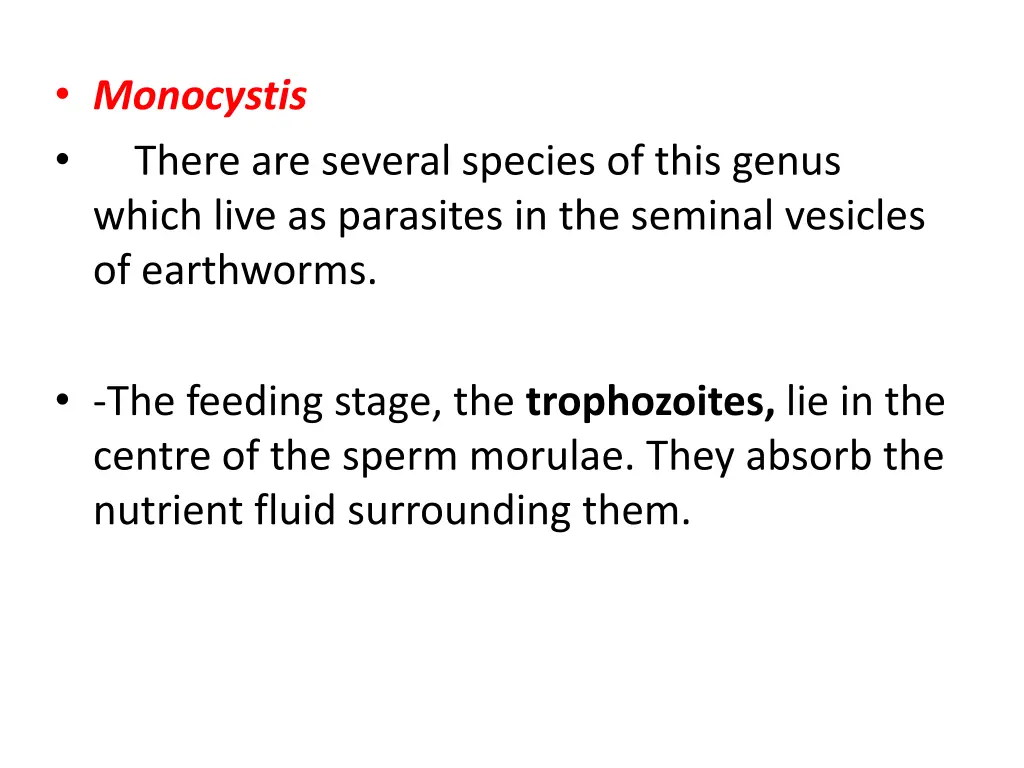
Monocystis Parasite Life Cycle in Earthworms
Monocystis is a genus of parasites that live in the seminal vesicles of earthworms, with a life cycle that involves trophozoites feeding on nutrient fluid, transforming into gametocytes, conjugating to form gametes, and ultimately producing sporozoites enclosed in cysts. The differences between Plasmodium and Monocystis lie in their intracellular vs. intercellular trophozoite location, male and female gamete types, motility of zygotes, and presence of cysts around sporozoites.
Download Presentation

Please find below an Image/Link to download the presentation.
The content on the website is provided AS IS for your information and personal use only. It may not be sold, licensed, or shared on other websites without obtaining consent from the author. If you encounter any issues during the download, it is possible that the publisher has removed the file from their server.
You are allowed to download the files provided on this website for personal or commercial use, subject to the condition that they are used lawfully. All files are the property of their respective owners.
The content on the website is provided AS IS for your information and personal use only. It may not be sold, licensed, or shared on other websites without obtaining consent from the author.
E N D
Presentation Transcript
Monocystis There are several species of this genus which live as parasites in the seminal vesicles of earthworms. -The feeding stage, the trophozoites, lie in the centre of the sperm morulae. They absorb the nutrient fluid surrounding them.
-As they feed, they grow transforming ultimately into gametocytes which conjugate in pairs and give rise to gametes . -Gametes from two associated gametocytes unite in pairs to form zygotes. -Each zygote secretes a resistant cyst, the pseudonavicella, within which it divides to produce 8 sporozoites. -The pseudonavicellae (infective stage) either escape through the vasa deferentia to the soil, or are eaten with the worm by a bird through the alimentary canal of which they pass out to the soil unaltered.
-On reaching the soil, they may be eaten by another worm whose digestive enzymes set free the sporozoites which attack sperm morulae to repeat the life cycle. The trophozoites appears inside a sperm-morula, first as a small nucleated body and later becomes cigar-shaped surrounded by the tails of the developing spermatozoa which shrivel up as tiny filaments.
The gametocytes are full grown trophozoites conjugating in pairs; each pair is surrounded by a thin cyst called the oocyst or gametocyst. The nucleus of each gametocyte undergoes multiple division (schizogony) giving rise to about 64 nuclei, each of which becomes surrounded by a small amount of cytoplasm, thus giving rise to the gametes; a small amount of cytoplasm, the residual cytoplasm, remains in the middle, while the gametes are then set free inside the gametocyst and fuse in pairs giving rise to the zygotes (sporoblasts).
Differences between Differences between Plasmodium&Monocystis Plasmodium&Monocystis Plasmodium Monocystis Trophozoit live intracellularly Trophozoit live intercellulariy The male and female gametes are different Isogametes The zygote is sessile The zygote is motile The sporozoites surrounded by cyst called pseudonavicella The sporozoites are naked
